22.3: Using Diagrams to Find the Number of Groups
- Page ID
- 40243
Lesson
Let's draw tape diagrams to think about division with fractions.
Exercise \(\PageIndex{1}\): How Many of These in That?
- We can think of the division expression \(10\div 2\frac{1}{2}\) as the question: “How many groups of \(2\frac{1}{2}\) are in 10?” Complete the tape diagram to represent this question. Then find the answer.
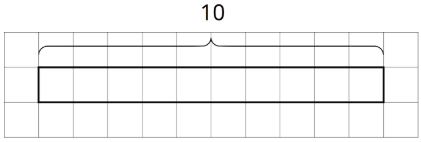
- Complete the tape diagram to represent the question: “How many groups of 2 are in 7?” Then find the answer.
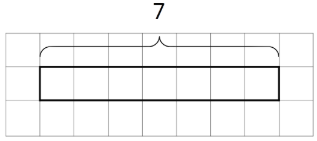
Exercise \(\PageIndex{2}\): Representing Groups of Fractions with Tape Diagrams
To make sense of the question “How many \(\frac{2}{3}\)s are in 1?,” Andre wrote equations and drew a tape diagram.
\(?\cdot\frac{2}{3}=1\)
\(1\div\frac{2}{3}=?\)
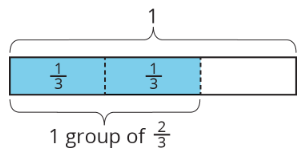
- In an earlier task, we used pattern blocks to help us solve the equation \(1\div\frac{2}{3}=?\). Explain how Andre’s tape diagram can also help us solve the equation.
- Write a multiplication equation and a division equation for each question. Then, draw a tape diagram and find the answer.
- How many \(\frac{3}{4}\)s are in \(1\)?
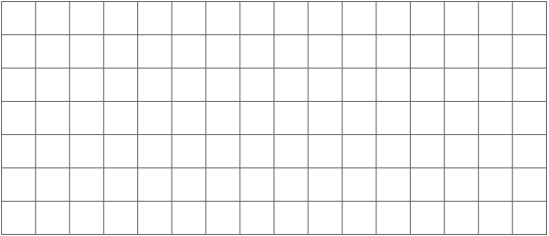
- How many \(\frac{2}{3}\)s are in \(3\)?

- How many \(\frac{3}{2}\)s are in \(5\)?

Exercise \(\PageIndex{3}\): Finding Number of Groups
- Write a multiplication equation or a division equation for each question. Then, find the answer and explain or show your reasoning.
- How many \(\frac{3}{8}\)-inch thick books make a stack that is 6 inches tall?
- How many groups of \(\frac{1}{2}\) pound are in \(2\frac{3}{4}\) pounds?
- Write a question that can be represented by the division equation \(5\div 1\frac{1}{2}=?\). Then, find the answer and explain or show your reasoning.
Summary
A baker used 2 kilograms of flour to make several batches of a pastry recipe. The recipe called for \(\frac{2}{5}\) kilogram of flour per batch. How many batches did she make?
We can think of the question as: “How many groups of \(\frac{2}{5}\) kilogram make 2 kilograms?” and represent that question with the equations:
\(?\cdot\frac{2}{5}=2\)
\(2\div\frac{2}{5}=?\)
To help us make sense of the question, we can draw a tape diagram. This diagram shows 2 whole kilograms, with each kilogram partitioned into fifths.
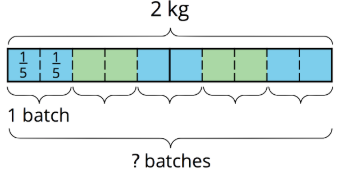
We can see there are 5 groups of \(\frac{2}{5}\) in 2. Multiplying 5 and \(\frac{2}{5}\) allows us to check this answer: \(5\cdot\frac{2}{5}=\frac{10}{5}\) and \(\frac{10}{5}=2\), so the answer is correct.
Notice the number of groups that result from \(2\div\frac{2}{5}\) is a whole number. Sometimes the number of groups we find from dividing may not be a whole number. Here is an example:
Suppose one serving of rice is \(\frac{3}{4}\) cup. How many servings are there in \(3\frac{1}{2}\) cups?
\(?\cdot\frac{3}{4}=3\frac{1}{2}\)
\(3\frac{1}{2}\div\frac{3}{4}=?\)

Looking at the diagram, we can see there are 4 full groups of \(\frac{3}{4}\), plus 2 fourths. If 3 fourths make a whole group, then 2 fourths make \(\frac{2}{3}\) of a group. So the number of servings (the “?” in each equation) is \(4\frac{2}{3}\). We can check this by multiplying \(4\frac{2}{3}\) and \(\frac{3}{4}\).
\(4\frac{2}{3}\cdot\frac{3}{4}=\frac{14}{3}\cdot\frac{3}{4}\), and \(\frac{14}{3}\cdot\frac{3}{4}=\frac{14}{4}\), which is indeed equivalent to \(3\frac{1}{2}\).
Practice
Exercise \(\PageIndex{4}\)
We can think of \(3\div\frac{1}{4}\) as the question “How many groups of \(\frac{1}{4}\) are in \(3\)?” Draw a tape diagram to represent this question. Then find the answer.
Exercise \(\PageIndex{5}\)
Describe how to draw a tape diagram to represent and answer \(3\div\frac{3}{5}=?\) for a friend who was absent.
Exercise \(\PageIndex{6}\)
How many groups of \(\frac{1}{2}\) day are in 1 week?
- Write a multiplication equation or a division equation to represent the question.
- Draw a tape diagram to show the relationship between the quantities and to answer the question. Use graph paper, if needed.
Exercise \(\PageIndex{7}\)
Diego said that the answer to the question “How many groups of \(\frac{5}{6}\) are in \(1\)?” is \(\frac{6}{5}\) or \(1\frac{1}{5}\). Do you agree with him? Explain or show your reasoning.
Exercise \(\PageIndex{8}\)
Select all the equations that can represent the question: “How many groups of \(\frac{4}{5}\) are in \(1\)?”
- \(?\cdot 1=\frac{4}{5}\)
- \(1\cdot\frac{4}{5}=?\)
- \(\frac{4}{5}\div 1=?\)
- \(?\cdot\frac{4}{5}=1\)
- \(1\div\frac{4}{5}=?\)
(From Unit 4.2.2)
Exercise \(\PageIndex{9}\)
Calculate each percentage mentally.
- What is \(10\)% of \(70\)?
- What is \(10\)% of \(110\)?
- What is \(25\)% of \(160\)?
- What is \(25\)% of \(48\)?
- What is \(50\)% of \(90\)?
- What is \(50\)% of \(350\)?
- What is \(75\)% of \(300\)?
- What is \(75\)% of \(48\)?
(From Unit 3.4.5)

